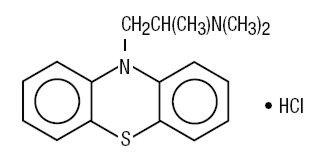Manufacturing Establishments (1)
ATLANTIC BIOLOGICALS CORP
047437707
Products (1)
promethazine hydrochloride
17856-0059
ANDA091675
ANDA (C73584)
ORAL
November 10, 2023
Drug Labeling Information
PACKAGE LABEL.PRINCIPAL DISPLAY PANEL
PRINCIPAL DISPLAY PANEL

DESCRIPTION SECTION
DESCRIPTION
Each teaspoonful (5 mL) of Promethazine Hydrochloride Syrup (Promethazine Hydrochloride Oral Solution, USP) contains 6.25 mg promethazine HCl in a flavored syrup base with a pH between 4.9 and 5.4. Alcohol 8%(v/v). The inactive ingredients present are: anhydrous citric acid, ascorbic acid, D&C yellow No. 10, edetate disodium, FD&C blue No. 1 powder, FD&C red No. 40, glycerin, methylparaben, natural and artificial strawberry banana flavor, natural fruit punch flavor, purified water, sodium benzoate, sodium citrate, sodium propionate, sodium saccharin, and sucrose.
Promethazine hydrochloride is a racemic compound; the empirical formula is C 17H 20N 2S•HCl and its molecular weight is 320.88.
Promethazine hydrochloride, a phenothiazine derivative, is designated chemically as 10H-Phenothiazine-10-ethanamine, N,N,α-trimethyl-, monohydrochloride, (±)- with the following structural formula:

Promethazine hydrochloride occurs as a white to faint yellow, practically odorless, crystalline powder which slowly oxidizes and turns blue on prolonged exposure to air. It is freely soluble in water and soluble in alcohol.
CLINICAL PHARMACOLOGY SECTION
CLINICAL PHARMACOLOGY
Promethazine is a phenothiazine derivative which differs structurally from the antipsychotic phenothiazines by the presence of a branched side chain and no ring substitution. It is thought that this configuration is responsible for its relative lack (1/10 that of chlorpromazine) of dopamine antagonist properties.
Promethazine is an H 1receptor blocking agent. In addition to its antihistaminic action, it provides clinically useful sedative and antiemetic effects.
Promethazine is well absorbed from the gastrointestinal tract. Clinical effects are apparent within 20 minutes after oral administration and generally last four to six hours, although they may persist as long as 12 hours. Promethazine is metabolized by the liver to a variety of compounds; the sulfoxides of promethazine and N-demethylpromethazine are the predominant metabolites appearing in the urine.
